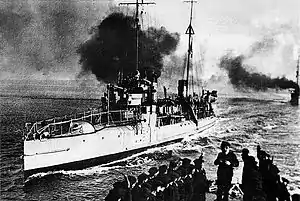Durandal-class destroyer
The Durandal class was a group of four destroyers built for the French Navy between 1896 and 1900, used during the First World War. These vessels were France's first true destroyers rather than torpedo boats. Two units were launched in 1899 while another two followed in 1900. Another four destroyers of the similar Samsun class were laid down in 1906 and completed in 1907 for the Ottoman Navy, they also served in the First World War.
 Hallebarde departing Toulon | |
| Class overview | |
|---|---|
| Name: | Durandal class |
| Builders: | Chantiers et Ateliers Augustin Normand, Le Havre |
| Operators: |
|
| Preceded by: | None |
| Succeeded by: | Framée class |
| Built: | 1899–1900 |
| In commission: | 1899–1921 |
| Completed: | 4 |
| Lost: | 1 |
| Scrapped: | 3 |
| General characteristics | |
| Displacement: | 301–311 t (296–306 long tons) |
| Length: | 57.5 m (188 ft 8 in) o/a |
| Beam: | 6.30 m (20 ft 8 in) |
| Draft: | 3.17 m (10 ft 5 in) |
| Installed power: |
|
| Propulsion: | 2 shafts; 2 triple-expansion steam engines |
| Speed: | 26 knots (48 km/h; 30 mph) |
| Range: | 2,300 nmi (4,300 km; 2,600 mi) at 10 knots (19 km/h; 12 mph) |
| Complement: | 52 |
| Armament: |
|
These vessels, which were an enlarged derivative of the previous Filibustier-class torpedo boats,[1] resembled the Havock class of Great Britain.[2] Its hull had a turtleback bow to reduce water resistance,[3] with two masts and two funnels. The ships were powered by two triple expansion engines fed by water tube boilers, giving a speed of 26 knots (48 km/h; 30 mph), and were armed by two torpedo tubes (with two reload torpedoes carried on board[1]), a 65 mm (2.6 in) and six 47 mm (1.9 in) guns.[4]
The Durandal destroyers were laid down between 1896 and 1897 and completed between 1899 and 1900.[4] Espingole struck a rock in the Bay of Cavalaire-sur-Mer off the South of France on 4 February 1903, which caused the ship to sink.[5] The three remaining destroyers served through the First World War, operating in both the English Channel and the Mediterranean Sea. They were sold for scrap in 1920–21.[6]
Durandal class
All four were built by Normand at Le Havre. The first pair (Durandal and Hallebarde) were ordered on 25 August 1896. They had a turtledeck forecastle and a flying deck aft, with two masts and two funnels widely separated by their machinery. The second pair (Fauconneau and Espignole) differed by having a strengthened hull and a slightly raised bow.
- Durandal – launched 11 February 1899, stricken 7 April 1919.
- Hallebarde – launched 8 June 1899, stricken 4 March 1920.
- Fauconneau – launched 2 April 1900, stricken 15 January 1921.
- Espingole – launched 28 June 1900, ran aground and lost 4 February 1903.
Samsun class
 Samsun in the Sea of Marmara, 1920s.
| |||||||||||||||||||||||||||||||||||||||||||
| |||||||||||||||||||||||||||||||||||||||||||
The Samsun class destroyers had similar dimensions to the Durandal class, but had more powerful machinery, more powerful armament, higher top speed and shorter range. Three of the four (Samsun, Yarhisar and Basra) were built by C A de la Gironde at Bordeaux, while Tasoz was built by Schneider at Nantes.[8] These ships suffered from mechanical problems due to poor maintenance and played little part in World War I. It was estimated that none could exceed 17 knots (31 km/h; 20 mph) in 1915. The Yarhisar was sunk in 1915 and the three surviving ships were scrapped in 1949.[7] Yarhisar was under the command of Lt. Cdr. Ahmet Hulusi and sank in the gulf of Izmit near Yalova on 3 December 1915 by the British submarine HMS E-11 under the command of Lt. Cdr. Naismith. The torpedo struck the engine room and the ships was torn in two. Forty-two of her crew (36 Turks and 6 Germans) died.[9]
- Samsun – laid up in 1918, repaired and recommissioned in 1924–1925, decommissioned in 1932, BU in 1949.
- Yarhisar – sunk December 3, 1915, by the British submarine HMS E11.
- Tasoz – laid up in 1918, repaired and recommissioned in 1924–1925, decommissioned in 1932, BU in 1949.
- Basra – laid up in 1918, repaired and recommissioned in 1924–1925, decommissioned in 1932, BU in 1949.
References
- Chesneau & Kolesnick, p. 323
- Osborne, p. 39
- Osborne, p. 186
- Chesneau & Kolesnick, p. 326
- "A French Destroyer Sunk: The Crew Saved". Sydney Morning Herald. 7 February 1903. p. 9. Retrieved 29 June 2012.
- Gardiner & Gray, p. 194
- "Samsun destroyers (1907) – Ottoman / Turkish Navy (Ottoman Empire / Turkey)". www.navypedia.org. Retrieved 4 August 2017.
- Langensiepen, Bernd (1995). The Ottoman steam navy, 1828–1923. Güleryüz, Ahmet, Cooper, James. Annapolis, Md.: Naval Institute Press. ISBN 9781557506597. OCLC 32754051.
- "Yarhisar Destroyer". www.wrecksite.eu. 21 September 2015. Retrieved 4 August 2017.
Bibliography
- Caresse, Philippe (2013). "The Unlucky Destroyer Espignole". In Jordan, John (ed.). Warship 2013. London: Conway. ISBN 978-1-84486-205-4.
- Chesneau, Roger & Kolesnik, Eugene M. (1979). Conway's All The World's Fighting Ships 1860–1905. London: Conway Maritime Press. ISBN 0-85177-133-5.
- Couhat, Jean Labayle (1974). French Warships of World War I. London: Ian Allan. ISBN 0-7110-0445-5.
- Gardiner, Robert & Gray, Randal (1985). Conway's All The World's Fighting Ships 1906–1921. London: Conway Maritime Press. ISBN 0-85177-245-5.
- Osborne, Eric W. (2005). Destroyers – An Illustrated History of Their Impact. Santa Barbara, California: ABC-Clio. ISBN 1-85109-479-2.
- Roche, Jean-Michel (2005). "Classement par types". Dictionnaire des bâtiments de la flotte de guerre française de Colbert à nos jours 2, 1870 – 2006. Toulon: Roche. ISBN 978-2-9525917-0-6. OCLC 165892922.
External links
| Wikimedia Commons has media related to Durandal-class destroyer. |
| Wikimedia Commons has media related to Samsun-class destroyer. |